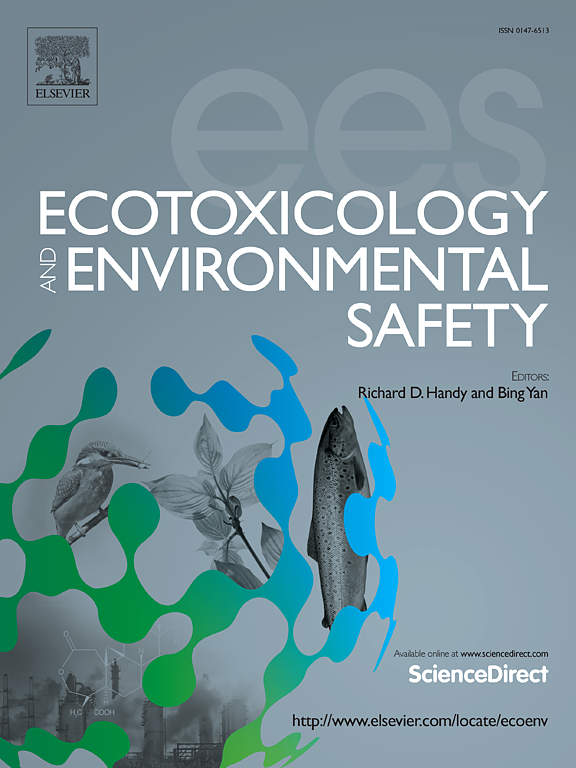Exogenous organic acids promoted phytoremediation by Hydrangea macrophylla in cadmium‑contaminated soil
IF 6.2
2区 环境科学与生态学
Q1 ENVIRONMENTAL SCIENCES
引用次数: 0
Abstract
Cadmium (Cd) contaminants with high toxicity and mobility seriously threatens the ecological environment and human safety. Hydrangea macrophylla is a potential plant for Cd-contaminated soil remediation. Exogenous organic acids have been proven to effectively enhance the phytoremediation of soil contaminated with Cd. However, research on the effects of organic acids on Cd tolerance and accumulation of H. macrophylla remains scarce. In this study, a potted experiment was performed with H. macrophylla as the research object. The effects of acetic acid (AA), citric acid (CA), and malic acid (MA) with different concentrations (2.5, 5, and 10 mmol·kg−1) on the growth physiology, Cd absorption and accumulation of H. macrophylla and soil microecological environment under Cd stress were systematically studied. Results indicated that organic acids increased chlorophyll content and promoted the growth of H. macrophylla, the biomass of shoots and roots increased by 165.44 % , 161.50 % under 5 mmol·kg−1 citric acid treatment. Furthermore, organic acids reduced the level of membrane lipid peroxidation in leaves, increased plant biomass and promoted root growth of H. macrophylla. By boosting superoxide dismutase (SOD), peroxidase (POD), and catalase activities (CAT), elevating levels of proline (Pro), non-protein thiol (NPT), glutathione (GSH) and phytochelatins (PCs), exogenous organic acids promoted the Cd tolerance of H. macrophylla. In particular, 5 mmol·kg−1 CA had the best effect on improving the Cd tolerance of H. macrophylla. The roots of H. macrophylla accumulated a large amount of Cd, ranging from 365.04 to1111.67 μg·plant−1. Appropriate concentration of organic acids increased the total Cd accumulation by 1.12–2.07 times of H. macrophylla. The translocation factor (TF) increased by 97.91 %, 107.95 % under 5 mmol·kg−1 CA and 10 mmol·kg−1 MA treatments. Nevertheless, TF values were all less than 1. We posit that using H. macrophylla and organic acids could reduce the Cd bioavailability in the soil mainly through rhizosphere immobilization and plant absorption. Additionally, organic acids increased the soil pH, accompanied by changes in soil enzyme activities. 10 mmol·kg−1AA and MA reduced the available Cd concentration by 20.42 % and 31.65 %, respectively. Overall, exogenous organic acids can assist H. macrophylla in phytoremediation. 5 mmol·kg−1 CA treatment was considered the best choice for the remediation of heavy Cd-contaminated soil by H. macrophylla.
外源有机酸促进大叶绣球在镉污染土壤中的植物修复。
镉(Cd)污染物具有高毒性和高流动性,严重威胁着生态环境和人类安全。大绣球是一种潜在的cd污染土壤修复植物。外源有机酸已被证明能有效增强植物对Cd污染土壤的修复能力,但有机酸对大叶红Cd耐受性和积累的影响研究较少。本研究以大叶水蛭为研究对象,进行盆栽试验。系统研究了不同浓度(2.5、5和10 mmol·kg-1)的乙酸(AA)、柠檬酸(CA)和苹果酸(MA)对Cd胁迫下大叶红生长生理、Cd吸收积累及土壤微生态环境的影响。结果表明,有机酸处理能提高大叶青叶绿素含量,促进其生长,在5 mmol·kg-1柠檬酸处理下,大叶青茎、根生物量分别提高165.44 %、161.50 %;此外,有机酸还能降低叶片膜脂过氧化水平,增加植物生物量,促进大叶红根系生长。外源有机酸通过提高超氧化物歧化酶(SOD)、过氧化物酶(POD)和过氧化氢酶(CAT)的活性,提高脯氨酸(Pro)、非蛋白硫醇(NPT)、谷胱甘肽(GSH)和植物螯合素(PCs)的水平,促进大叶红对Cd的耐受。其中,5 mmol·kg-1 CA对提高巨叶水杨耐Cd性的效果最好。大叶黄根累积Cd量较大,为365.04 ~ 1111.67 μg·plant-1。适当浓度的有机酸可使大叶蝉累积Cd总量增加1.12 ~ 2.07倍。在5 mmol·kg-1 CA和10 mmol·kg-1 MA处理下,转运因子(TF)分别提高了97.91 %和107.95 %。但TF值均小于1。研究认为,大叶黄和有机酸的使用主要通过根际固定和植物吸收来降低土壤中Cd的生物有效性。有机酸增加了土壤pH值,并引起土壤酶活性的变化。10 mmol·kg-1AA和MA分别使有效镉浓度降低20.42%和31.65%。综上所述,外源有机酸可以帮助巨叶水杨进行植物修复。5 mmol·kg-1 CA处理被认为是大叶茅修复重镉污染土壤的最佳选择。
本文章由计算机程序翻译,如有差异,请以英文原文为准。
求助全文
约1分钟内获得全文
求助全文
来源期刊
CiteScore
12.10
自引率
5.90%
发文量
1234
审稿时长
88 days
期刊介绍:
Ecotoxicology and Environmental Safety is a multi-disciplinary journal that focuses on understanding the exposure and effects of environmental contamination on organisms including human health. The scope of the journal covers three main themes. The topics within these themes, indicated below, include (but are not limited to) the following: Ecotoxicology、Environmental Chemistry、Environmental Safety etc.

 求助内容:
求助内容: 应助结果提醒方式:
应助结果提醒方式:


